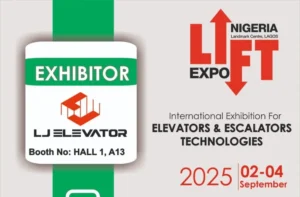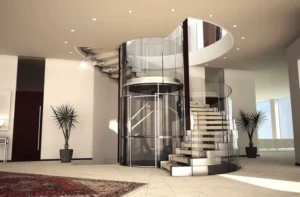Elevators play a crucial role in modern buildings, ensuring efficient and comfortable vertical transportation. From office buildings and hotels to hospitals and residential towers, selecting the right elevator system impacts performance, energy efficiency, and long-term costs.
Among the different types of elevators, traction elevators are widely used due to their efficiency and smooth operation. These elevators function with a counterweight system and move using steel ropes or belts, making them more energy-efficient than hydraulic elevators.
There are two main types of traction elevators:
- Geared traction elevators – Common in mid-rise buildings, offering reliable performance at moderate speeds.
- Gearless traction elevators – Designed for high-rise buildings, providing higher speeds, better efficiency, and a smoother ride.
Understanding the differences between these two types will help in selecting the best option for your building.
What is a geared traction elevator?

A geared traction elevator uses a gearbox connected to the motor to drive the traction sheave, which moves the elevator via steel ropes or steel belts. This system allows for controlled movement and moderate speeds, making it ideal for mid-rise buildings.
Key features of geared traction elevators:
- Designed for mid-rise buildings
- Requires a machine room for motor and gearbox installation
- Moderate speeds suitable for everyday use
- Lower initial installation cost compared to gearless systems
- Requires regular maintenance due to the gearbox components
Common applications:
- Mid-rise residential and commercial buildings
- Hotels and shopping centers
- Hospitals and office buildings
While geared traction elevators are reliable and cost-effective, their speed and height limitations make them unsuitable for very tall buildings.
What is a gearless traction elevator?

A gearless traction elevator eliminates the gearbox, allowing the motor to directly drive the traction sheave. This reduces friction, improves efficiency, and allows for faster speeds. These elevators are typically used in high-rise and ultra-high-rise buildings.
Key features of gearless traction elevators:
- Ideal for high-rise and ultra-high-rise buildings
- Can be designed as machine-room-less (MRL) to save space
- Higher speeds than geared elevators
- More energy-efficient, with reduced mechanical losses
- Smoother, quieter ride due to fewer moving parts
- Longer lifespan with minimal maintenance needs
Common applications:
- High-rise office towers
- Luxury residential buildings
- Landmark skyscrapers and commercial complexes
Gearless traction elevators are preferred for high-rise applications due to their efficiency, speed, and lower maintenance costs over time.
Key differences between geared and gearless traction elevators
| Feature | Geared Traction Elevator | Gearless Traction Elevator |
| Building Height | Suitable for mid-rise buildings | Best for high-rise and ultra-high-rise buildings |
| Speed | Moderate | Faster than geared elevators |
| Energy Efficiency | Less efficient due to gearbox friction | More efficient with direct drive |
| Ride Comfort | Some vibration and noise | Smoother, quieter operation |
| Maintenance | Requires gear lubrication and inspections | Requires motor and system checks |
| Installation Cost | Lower | Higher upfront cost |
| Space Requirement | Requires machine room | Can be machine-room-less (MRL) |
| Best For | Malls, hotels, mid-rise offices | High-rise towers, luxury projects |


1. Building height and speed
Geared traction elevators are best for mid-rise buildings, where moderate speeds are acceptable.
Gearless traction elevators are faster and better suited for high-rise buildings.
2. Machine room requirements
Geared elevators require a machine room above the shaft.
Gearless elevators can be machine-room-less (MRL), saving valuable building space.
3. Energy efficiency
Gearless traction elevators consume less power, making them more energy-efficient.
Geared elevators have higher energy consumption due to mechanical losses in the gearbox.
4. Maintenance and lifespan
Geared elevators need regular lubrication and maintenance.
Gearless elevators have fewer moving parts, making them easier to maintain and more durable.
5. Cost considerations
Geared traction elevators have lower initial costs but require more frequent maintenance.
Gearless traction elevators are more expensive upfront but cost less to operate and maintain over time.
Which one should you choose?
The right choice depends on building height, budget, and performance requirements.
Choose a geared traction elevator if:
- Your building is mid-rise and doesn’t require very high speeds.
- You need a lower-cost installation with a standard machine room.
- Maintenance is not a major concern as long as regular servicing is performed.
Choose a gearless traction elevator if:
- Your building is high-rise or ultra-high-rise and needs faster speeds.
- You prefer an energy-efficient solution with lower long-term costs.
- You need an MRL (machine-room-less) design to save space.
Final recommendation:
For mid-rise buildings, a geared traction elevator is an economical and reliable choice.
For high-rise and landmark projects, a gearless traction elevator offers the best performance and long-term efficiency.
About LJ Elevator
At LJ Elevator, we specialize in advanced traction elevator solutions, offering both geared and gearless traction systems tailored to different building needs.
We focus on safety, energy efficiency, and cutting-edge technology to provide smooth and reliable elevator experiences.
Looking for the perfect elevator solution? Contact LJ Elevator today to explore our customized traction elevator systems.





